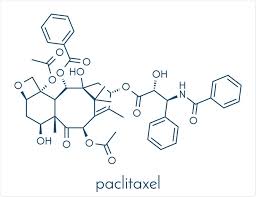Paclitaxel is a widely used chemotherapy drug that plays a crucial role in the treatment of various cancers, including breast cancer, ovarian cancer, and non-small cell lung cancer. Known for its ability to inhibit cell division, Paclitaxel helps to prevent the growth and spread of cancer cells. However, like all potent medications, its use comes with potential side effects, and each patient’s response may vary. In this article, we will explore the uses, benefits, side effects, and dosage information about Paclitaxel, as well as its role in modern cancer therapy.
What is Paclitaxel and How Does It Work?
Paclitaxel is a naturally occurring compound derived from the Pacific yew tree and is classified as a taxane chemotherapy drug. It works by stabilizing microtubules, which are essential components of the cell’s cytoskeleton. This stabilization prevents the microtubules from breaking down during cell division, which ultimately halts the cancer cells’ ability to proliferate. As a result, Paclitaxel can slow down or even shrink tumors in many cancer patients.
Uses of Paclitaxel in Cancer Treatment
Paclitaxel is a versatile drug that is commonly used to treat various forms of cancer. The most frequent uses include:
- Breast Cancer: Paclitaxel is a standard chemotherapy treatment for breast cancer, especially in cases of HER2-negative or hormone receptor-positive (HR+) cancer. It helps to prevent the spread of cancer cells and reduce tumor size.
- Ovarian Cancer: For patients with advanced ovarian cancer, Paclitaxel is often used in combination with other chemotherapy drugs to increase its effectiveness.
- Lung Cancer: Non-small cell lung cancer (NSCLC) is another type of cancer that can be treated effectively with Paclitaxel. It is often combined with other chemotherapy agents to improve overall treatment outcomes.
Paclitaxel vs Taxol: Are They the Same?

Side Effects of Paclitaxel and How to Manage Them
While Paclitaxel is highly effective in treating various cancers, it is associated with certain side effects. The severity of these side effects can vary depending on the individual, but some of the most common include:
- Hair Loss: One of the most common side effects of Paclitaxel is hair loss. This typically begins a few days after treatment and is usually temporary. Once treatment ends, hair generally regrows.
- Neuropathy: Peripheral neuropathy, which involves symptoms like numbness, tingling, or pain in the hands and feet, is another possible side effect. This happens because Paclitaxel can affect the nervous system.
- Immune Suppression: Paclitaxel suppresses the immune system, which can increase the risk of infections. Regular blood tests to monitor white blood cell counts are important during treatment.
These side effects can often be managed by adjusting the dosage, using supportive medications, or changing the frequency of treatment. It is crucial for patients to communicate closely with their healthcare providers to ensure timely management of any side effects.
What Does Paclitaxel Do in the Body?
Paclitaxel primarily affects cancer cells by preventing cell division. It interferes with the function of microtubules, which are protein filaments that form the scaffolding of the cell. These microtubules are essential for processes like mitosis (cell division). By stabilizing these structures, Paclitaxel essentially “freezes” the cancer cells in the middle of division, preventing them from multiplying and spreading.
In addition to halting cell division, Paclitaxel can also induce programmed cell death, or apoptosis, in cancer cells. This combined mechanism of action makes it an effective treatment for slowing down or eliminating tumors.
Dosage and Administration of Paclitaxel
Paclitaxel is administered intravenously, usually over a period of several hours. The dosage and frequency depend on the specific type of cancer being treated, the patient’s overall health, and whether the drug is used in combination with other chemotherapy medications.
- Dosage Calculation: Paclitaxel is generally dosed based on the patient’s body surface area (BSA), which is determined by the patient’s height and weight. This allows the medical team to tailor the dosage to the individual’s needs.
- Administration Schedule: The drug is often given once a week or once every three weeks, depending on the treatment plan. In some cases, Paclitaxel may be combined with other chemotherapy drugs like cyclophosphamide or carboplatin.
- Infusion Time: Paclitaxel is infused slowly over a period of 3 hours to reduce the risk of side effects, especially those related to allergic reactions.
How Effective is Paclitaxel in Cancer Treatment?
Paclitaxel has proven to be highly effective in treating various forms of cancer, particularly breast cancer, ovarian cancer, and non-small cell lung cancer. Numerous clinical studies have shown that Paclitaxel can reduce tumor size, slow cancer progression, and improve survival rates in many patients.
However, the effectiveness of Paclitaxel can vary depending on the individual. Some patients may develop resistance to the drug over time, while others may experience significant tumor shrinkage. Personalized treatment plans and careful monitoring are essential to achieving the best possible outcomes.
Paclitaxel Drug Interactions
Like many chemotherapy drugs, Paclitaxel may interact with other medications, potentially affecting its effectiveness or increasing the risk of side effects. Key drug interactions to watch for include:
- CYP3A4 Inhibitors: Drugs that inhibit the CYP3A4 enzyme, such as certain antibiotics and antifungals, can interfere with the metabolism of Paclitaxel, increasing its concentration in the blood.
- Immunosuppressive Drugs: Paclitaxel may interact with immunosuppressive medications, which can further suppress the immune system and increase the risk of infections.
Patients should inform their healthcare providers about all medications they are currently taking to help avoid potential interactions and ensure optimal treatment planning.
Conclusion: Why Choose Us for Your Paclitaxel Sourcing Needs?
At Xi’an Herb Bio, we pride ourselves on providing high-quality paclitaxel raw materials to meet the needs of pharmaceutical and research industries. Whether you’re developing life-saving cancer treatments or conducting cutting-edge research, our paclitaxel is sourced and manufactured to the highest standards.
We understand the importance of reliable, effective, and affordable sourcing in the pharmaceutical industry. With our commitment to quality, transparency, and customer support, we’re confident that we can help you achieve your goals and meet your production requirements.
Interested in sourcing paclitaxel from a trusted supplier? Contact us today for a quote or more information about our products. Our team is here to assist with your order, and we are happy to discuss how our paclitaxel can support your business.
Request a quote or ask any questions now – we are here to ensure your success!





Leave A Comment